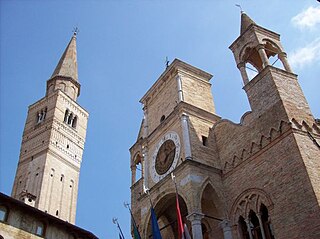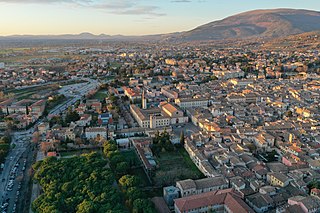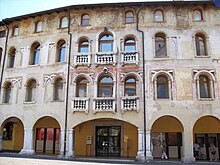
The Capitolium or Capitoline Hill, between the Forum and the Campus Martius, is one of the Seven Hills of Rome.

Todi is a town and comune (municipality) of the province of Perugia in central Italy. It is perched on a tall two-crested hill overlooking the east bank of the river Tiber, commanding distant views in every direction. It was founded in antiquity by the Umbri, at the border with Etruria; the gens Ulpia of Roman emperor Trajan came from Todi.

Palazzo Farnese or Farnese Palace is one of the most important High Renaissance palaces in Rome. Owned by the Italian Republic, it was given to the French government in 1936 for a period of 99 years, and currently serves as the French embassy in Italy.

The Grand Canal is the largest channel in Venice, Italy, forming one of the major water-traffic corridors in the city.

Pordenone is a city and comune (municipality) in the Italian region of Friuli-Venezia Giulia, the capital of the Regional decentralization entity of Pordenone.

Gubbio is an Italian town and comune in the far northeastern part of the Italian province of Perugia (Umbria). It is located on the lowest slope of Mt. Ingino, a small mountain of the Apennines.

Foligno is an ancient town of Italy in the province of Perugia in east central Umbria, on the Topino river where it leaves the Apennines and enters the wide plain of the Clitunno river system. It is located 40 kilometres south-east of Perugia, 10 km (6 mi) north-north-west of Trevi and 6 km (4 mi) south of Spello.

Spello is an ancient town and comune (township) of Italy, in the province of Perugia in eastern-central Umbria, on the lower southern flank of Monte Subasio. It is 6 km (4 mi) NNW of Foligno and 10 km (6 mi) SSE of Assisi. It is one of I Borghi più belli d'Italia.

The Palazzo Vecchio is the town hall of Florence, Italy. It overlooks the Piazza della Signoria, which holds a copy of Michelangelo's David statue, and the gallery of statues in the adjacent Loggia dei Lanzi.

Jesi is a comune (municipality) in the province of Ancona, in the Italian region of Marche.

The Palazzo Medici, also called the Palazzo Medici Riccardi after the later family that acquired and expanded it, is a Renaissance palace located in Florence, Italy. It is the seat of the Metropolitan City of Florence and a museum.

The Palazzo Barberini is a 17th-century palace in Rome, facing the Piazza Barberini in Rione Trevi. Today, it houses the Galleria Nazionale d'Arte Antica, the main national collection of older paintings in Rome.

The National Roman Museum is a museum, with several branches in separate buildings throughout the city of Rome, Italy. It shows exhibits from the pre- and early history of Rome, with a focus on archaeological findings from the period of Ancient Rome.
Prata di Pordenone is a comune (municipality) in the Regional decentralization entity of Pordenone, in the Italian region of Friuli-Venezia Giulia, located about 100 kilometres (62 mi) northwest of Trieste and about 8 kilometres (5 mi) southwest of Pordenone.

The Palazzo della Consulta is a late Baroque palace in central Rome, Italy; since 1955, it houses the Constitutional Court of the Italian Republic. It sits across the Piazza del Quirinale from the official residence of the President of the Italian Republic, the Quirinal Palace.

The Palazzo Comunale, also known as the Palazzo del Popolo of San Gimignano has been the seat of the civic authority in the comune since the 13th century. It is located on the Piazza del Duomo close to the Collegiate Church of the Assumption of the Blessed Virgin Mary. The building and Collegiate Church are at the heart of the medieval town, and are part of the UNESCO World Heritage Site of the "Historic Centre of San Gimignano".

The Palazzo dei Consoli is a Gothic architecture, civic building in the historic center of Gubbio, region of Umbria, Italy. Construction took place during 1332–1349 under design by Angelo da Orvieto; the palace was built on a large platform built against the hillside and looming over the town below.

The Palazzo Botta or Botta Adorno is a Neoclassical-style palace with a long facade along Via Lanfranco and Piazza Botta Adorno Antoniotto in the town of Pavia, region of Lombardy, Italy. Once the family home of the aristocratic Botta family, it presently houses the Natural History Museum of Pavia and the Museum Camillo Golgi.

The Palazzo dei Priori is a Gothic-style monumental civic building in the center of the town of Volterra, located on the Piazza dei Priori, also known as Piazza Maggiore. The imposing 13th-century stone building once the office of appointed town magistrates, still has offices of the local commune, including the communal council, for Volterra, province of Pisa, region of Tuscany, Italy.

San Salvatore dei Fieschi, also known as the Basilica dei Fieschi is a Romanesque-Gothic style church, now converted into a parish church and minor basilica, located on Piazza Innocenzo IV in a hamlet of San Salvatore, a neighborhood of the commune of Cogorno in the Metropolitan City of Genoa, region of Liguria, Italy.



















